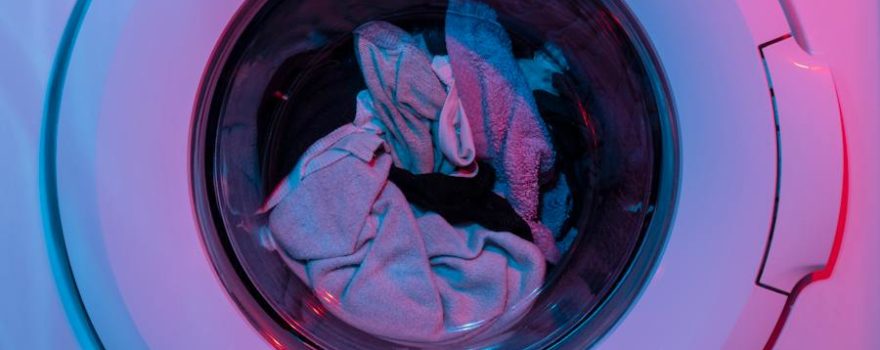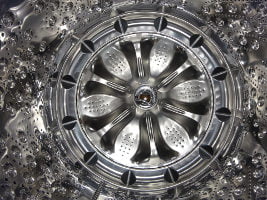
It might seem a bit odd, that an appliance that’s designed to get your clothes clean could need cleaning itself. But If you’ve had that conversation with a friend where you’ve complained ‘my washing machine smells‘. it’s a fair bet that your washer could do with a spring clean.
Washing machines are vulnerable to invasion by moulds and mildew. If you generally use biological detergents and low-temperature cycles there could be bacteria in there too. That’s the bad news. The good news is that it’s a relatively simple job. Read on to find out all about the best way to clean a washing machine.
Where should you be cleaning?
Cleaning the Filter
The filter in a washing machine is designed to trap lint, hair, and other debris from the laundry. If this becomes obstructed it can result in the washing machine not cleaning effectively. You may need to check the manufactures manual for how to locate and remove the filter for cleaning.
Often when you open the filter door and loosen the filter there will be a stream of excess water running through, so have an old towel handy to soak up any moisture.
Once you have the loose filter you can pull off any visible lint and then run it under warm water to get rid of any remaining dust. Wipe down with a clean cloth before re-inserting into the washing machine.
The drum itself is not the biggest problem. Mould is most likely to lurk in the hard-to-access places that retain moisture when the machine’s not in use, basically, that’s in and behind the gasket around the door, and also in the rubber hoses that drain the water at the end of the cycle.
Cleaning the Gasket
Figuring out how to clean the washing machine drum seal is a little tricky because it’s designed to fit tightly and you don’t want to dislodge it or damage it. Open the washing machine door and take a good look at the gasket, you may be able to turn it inside out, if so your life just got easier, if not you’re going to have to gently clean it with the rubber in place.
Start with a dry cloth, and rub this around the entire gasket. If the gasket can’t be turned inside out it’s best to cover a finger with the cloth and push into the rubber. If the seal is dirty you’ll see the mould and mildew on the rag when you pull the cloth out. Keep doing this until the cloth is coming out clean. Next, make up a mix of one part bleach and ten parts water, spray this onto the seal if you can, or onto the cloth if you can’t. Again work your way around until you’ve cleaned all the rubber. The water/bleach mix will both lift more dirt and also kill off fungal spores and any bacteria or viruses that are hidden in the machine.

Cleaning the drum and hoses
This is the easy bit. Simply put a cup of bleach into the detergent compartment and run an empty cycle using the hottest and longest setting you have available to you. Add an extra rinse cycle for good measure. At the end of the cycle open the door. If you can still smell bleach run another hot cycle without any extra cleaning products. The combination of bleach and hot water will sanitise your machine, get rid of those unpleasant odours and mean that in future your clothes will come out cleaner and smelling fresher.
Alternative cleaning products
Can you put bleach in a washing machine? The answer to this frequently asked question is yes. Bleach in your washing machine can resolve any bacterial issues completely sanitising as it washes – leaving the appliance free of harmful viruses.
The process of how to clean washing machine with bleach is simple and easy to follow along. Put 60ml of neat bleach into the detergent drawer. Run the machine empty and on a hot cycle, followed by an extra rinse cycle to ensure all the bleach is flushed away. The addition of bleach to the detergent drawer will help clean that area too.
Bear in mind that excessive bleach, when combined with hot water, can produce a lot of foam so make sure you accurately measure the dose. Also, bleach, when used with other cleaning products, can react adversely resulting in damage to your washing machine.
White vinegar and baking soda can provide you with an easy and effective clean. Make a solution of one-two teaspoons of water to three tablespoons of bicarbonate of soda and mix to a thick paste. Put this into the detergent drawer. Add 250ml of white vinegar into the drum before running the washing machine on a hot wash.
Unpleasant smells in your appliance will be neutralised by the combination of the ingredients, and grime and detergent residue eliminated. You may need to run another hot cycle to get rid of any odour left by the white vinegar.
Soda crystals are another effective way of dissolving grease and eliminating odours. Adding 500g of pure soda crystals to the drum and running the appliance on a long, hot wash will result in a clean and sanitised washing machine.
Citric acid is a good choice if you want to remove limescale build up. A 3% solution of hydrogen peroxide is a reasonable alternative to bleach if you have a strong objection to chlorine fumes, but it takes longer to work. You’ll need to start the hot cycle then pause it with water in the washing machine for three hours or so to get the best effect.
Keeping the machine clean
Don’t use an excessive range of products as the more detergent and fabric softeners you use only increases the amount of residue left inside the washing machine. Additional products should only be used for tough stains or heavy soiling.
Make sure you empty the washing machine as soon as the cycle has finished as leaving laundry sitting will encourage damp and musty smells.
De-scale the appliance on a regular basis as water contains minerals that can combine to form limescale. When limescale is allowed to build up it can make your washing machine less efficient and effective, and more expensive to run. Use a quality descaler every three to six months to ensure no damage is caused. If your area has a hard water supply you may need to increase the frequency of the descaling process.
Run a weekly hot water cycle as this should kill off any bacteria and sanitise your machine. A cool wash is better for the environment but not as effective in killing germs.
Cleaning your washing machine properly will keep your appliance running effectively and help extend its lifespan. You’ll get better results on your laundry, and both the washing machine and laundry will benefit from smelling fresh and being hygienically clean.
Leave the door open after a wash, it doesn’t need to be wide open, just not latched. Fresh, circulating air is the enemy of all types of fungal spores and making sure that your washing machine is dry between cycles will make the difference between your clothes coming out sweet and fresh or smelling like old socks.
If you are ever in need of appliance repair services in East London, feel free to call Mix Repairs or book online a visit from our experienced engineers.



